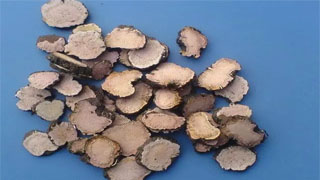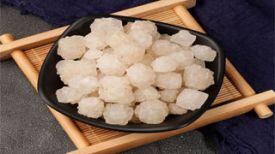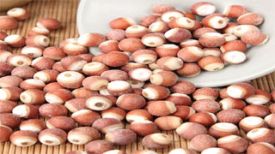
1. Alias
Purple ginseng, mountain shrimp, knot ginseng, Mu Meng, Zhong Rong, Tong Chang.
2. Plant morphology
Perennial herb, 35-85 cm tall. The rhizome is thick and often curved, with a surface that is brown to dark brown with a dark purple tint. The stem is single, unbranched, hairless, with longitudinal grooves. The basal leaves have long stalks, ranging from 15 to 35 centimeters in length. The leaves are oblong lanceolate or lanceolate in shape, with a long and gradually pointed tip and a rounded or truncated base. They extend along the petiole into narrow wings, with the edges curled outward. Both sides are slightly hairy and gradually shed as they age; The stem and leaves alternate, and the stem gradually shortens upwards until it embraces the stem; The sheath is cylindrical and membranous. The inflorescence is spike shaped, terminal, cylindrical, upright or slightly curved, with dense small flowers. The bracts are ovate, membranous, light brown, and the midrib is dark and distinct. The flower stalks are slender, and the perianth is light red or white, with 5 petals and an oval shape; Stamen 8, slightly longer than the perianth; Style 3. The achene is oval in shape, with 3 edges, brown in color, slightly shiny, and enclosed in the perennial calyx. The flowering period is from June to September, and the fruiting period is from September to November.
3. Origin distribution
Born on higher slopes, grasslands, or damp meadows in the forest. Distributed in Jilin, Liaoning, Hebei, Shanxi, Inner Mongolia, Shaanxi, Xinjiang and other places.
4. Harvesting and processing
In autumn and winter, dig up roots and stems, remove residual stems, leaves, and fibrous roots, and dry them in the sun.
5. Characteristics of medicinal herbs
Flat cylindrical, often bent into a shrimp shape, with rounded or slightly slender ends. The surface is purple brown or purple black, slightly rough, with dense links and root marks. One side is raised, and the other side is relatively flat or slightly grooved. Hard in texture, with a kidney shaped cross-section, light brownish red in color, and dozens of yellow white dots arranged in intermittent rings. Mild odor and bitter taste.
6. Sexual Taste Returning to the Classics
Slightly cold in nature, with a bitter and astringent taste. Return to the lung meridian, liver meridian, and colon meridian.
7. Effect and Function
Clearing heat and detoxifying, stopping bleeding, and reducing swelling. Belonging to the subcategory of clearing heat and detoxifying drugs.
8. Clinical application
Use 3-10 grams, double the amount for fresh use, take the decoction orally, and apply an appropriate amount of decoction, wash with water, or massage externally. Used to treat damp heat diarrhea, dysentery, hepatitis, blood heat, vomiting blood, bleeding, collapse, rectal bleeding, hemorrhoids, etc. For external bleeding, unnamed swelling, and boils, fresh products can be used to massage and apply to the affected area. Throat swelling and pain, mouth and tongue sores, can be washed with a single decoction or swallowed. In addition, this product can also be used orally to treat warm diseases, high fever, convulsions, and seizures. It is often added to antispasmodic drugs for simultaneous use.
9. Pharmacological research
The in vitro experiment of extracting ginseng has antibacterial effects on Staphylococcus aureus, Pseudomonas aeruginosa, Bacillus subtilis, Escherichia coli, and other bacteria. The preparation made of ginseng filtrate and gelatin has a certain hemostatic effect. It has been found to have a certain inhibitory effect on tumor cells. It can significantly reduce cholinesterase activity and lower cholesterol in rat serum and liver, and has a preventive effect on diabetes caused by alloxan in rats.
10. Chemical composition
Containing gallic acid, gallic acid, hydrolyzed tannins, and condensed tannins. It also contains isomers of hydroxymethylanthraquinone, vitamin C, and β - sitosterol. It also contains components such as right-handed catechol, left-handed epicatechin, 6-galloyl glucose, 3,6-digallic acid glucose, and glucose.
11. Usage taboos
Fist ginseng has low toxicity and should be taken with caution for those without solid fire or heat. It is contraindicated for patients with genital warts.
12. Compatibility prescription
① Treating dysentery: 12 grams of fresh ginseng, 12 grams of fresh dandelion, and 9 grams of fresh Scutellaria baicalensis. Boil it in water. Children should be reduced accordingly. (National Compilation of Chinese Herbal Medicines)
② Treatment of chronic bronchitis: 9g of ginseng, 9g of dried tangerine peel, and 6g of licorice. Boil it in water. (Xining Chinese Herbal Medicine)
③ Treatment of acute tonsillitis: 9g of ginseng and 15g of dandelion. Boil it in water. (Xining Chinese Herbal Medicine)
④ Treating burns and scalds: Grind ginseng powder and mix sesame oil evenly on the affected area, 1-2 times a day. (Guizhou Province Chinese Herbal Medicine Data)
⑤ Treatment of hematemesis: Fist ginseng, ginseng, ass hide glue (stir fried), etc. At the end. Take 3 grams of Ume Soup; On the other hand, remove ginseng, add licorice, and take glutinous rice soup. (Holy Blessing Formula)
⑥ Treatment for hemoptysis, nosebleeds, and gastric ulcers: 45g of ginseng, finely ground. Take 4.5 grams per dose, twice a day. (Handbook of Chinese Herbal Medicine in Ningxia)
⑦ Treatment of hemorrhoid bleeding: Boil 15 grams of ginseng in water and fumigate and wash the affected area. (Southern Medicine "Chinese Herbal Medicine")
⑧ Treatment of unnamed swelling and toxin: Take 6-9g of ginseng root and decoct it in water. (Hunan Pharmaceutical Journal)
⊙ The content of the article is for clinical reference only. Non TCM professionals are not allowed to test drugs.


